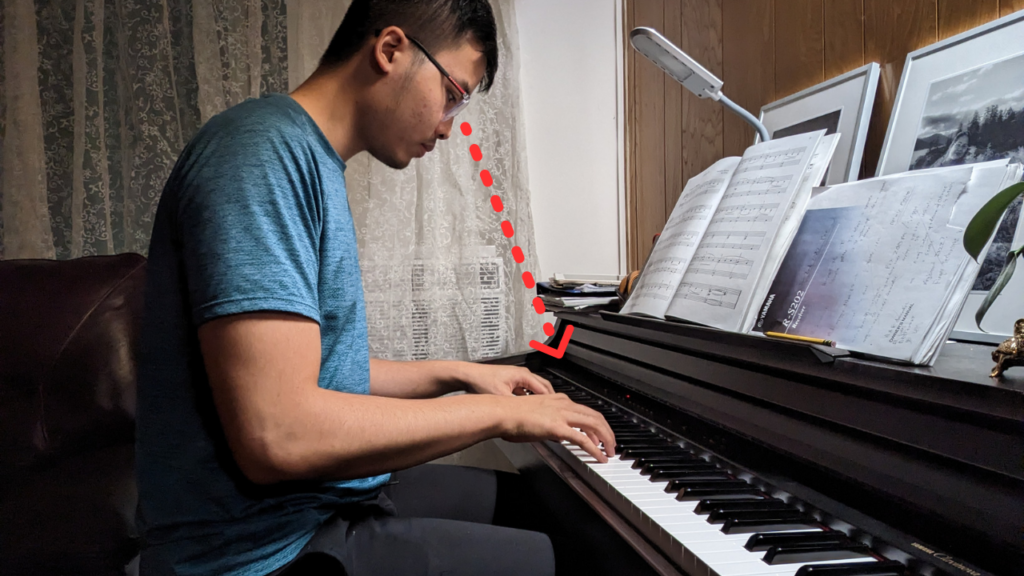This post contains affiliate links.
If you have played piano for a while, you may have heard or read that looking at your hands while playing is a bad habit. Is this true? And if so, why? I have always wondered about this because I look at my hands more than the sheet music. So, I ask my teacher about it and read forums online to see what the consensus is.
It is ok to look at your hands when playing piano because it’s challenging to play otherwise, as you don’t know where the keys are. Knowing where the keys are without looking is a skill built through years of sight-reading training and familiarizing yourself with the keyboard.

With that said, if you can learn to play without looking at your hands, you’ll improve significantly and quickly. Continue reading to learn if professional pianists look at their hands while playing. I’ll also share some tips for learning to play without looking at your hands.
Do pianists look at their hands when playing?
Professional pianists don’t need to look at their hands when playing because they’ve already memorized where the keys are. That’s how they can play with their eyes closed. However, they sometimes glance at the keyboard for large jumps (more than 1-2 octaves) or difficult parts of a piece.
Pianists learn to know where the keys are without looking through years, even decades, of training and honing their skills playing the piano. That’s why if you hand them sheet music for a piece they don’t know and tell them to play on the spot, they can read it and play the notes simultaneously without practice beforehand.
It’s similar to people that can type with ten fingers. With enough practice, they memorize where the letters are on the keyboard and can type accurately while looking at the screen.
Another pro of knowing where the keys are is that pianists can play accurately and effortlessly while closing their eyes. Watch this video of Lang Lang’s performance of the Turkish March. He exaggerated his eyes so much; it’s as if he’s saying: “Look at me; I can play without looking at my hands!”:
Even when looking at his hands, he’s more focused on the music and not on “which notes do I play next?”. Plus, without sheet music, where else would he look but the keyboard and his hands?
On the same note, have you ever wondered why pianists make funny faces while playing or lift their hands so high up? Well, check out my article, 7 Quirky Things Pianists Do During Performances.
Is it ok to look at your hands when playing piano?
As I’ve mentioned above, it’s ok to look at your hands while playing because playing otherwise is a skill you must build through years of playing the piano.
Even when you’ve memorized a piano piece and can comfortably play without sheet music, it’s another challenge to play without looking at your hands.
Try it out! Take a piece you’re comfortable playing and try to play it with your eyes closed. I bet you make some mistakes while playing unless the piece has your hands in the same spot. I make mistakes when playing with my eyes closed, even with pieces I’ve practiced for months.
So if you’re a beginner, don’t worry too much about looking at your hands while playing. There are more important things to work on, like how quickly and accurately you can play or play loudly and softly, etc. You’ll get better with time and practice. Remember that even the pros look at their hands sometimes!
The only time that you mustn’t look at your hands is when you’re sight-reading. The goal of sight-reading exercises is to train you to look at a piece of sheet music and play at the same time without any practice beforehand.
The teacher will give you an excerpt or a small piece you have never seen before, have you quickly scan it with your eyes, and immediately play it. Thus, you don’t have time to look at your hands; you have to look at the sheet music to know what note to play next.
How to stop looking at your hands when playing piano?
Before I share my tips, I want you to understand that it’s a long process, and you must be patient. You can’t just practice one day and wake up the next day being able to play with your eyes closed. You’re developing a sixth sense in your mind by learning how to play without looking at your hands.
Without further ado, here are my tips for learning to play without looking at your hands the whole time:
1. Practice pieces you’ve memorized with your eyes closed
Once you can comfortably play your piece, you can take it to the next level by playing it while closing your eyes. This helps you better memorize the piece and develops that sixth sense for knowing where the keys are.
2. Sight-reading
Sight-reading is the best way to learn to play without looking at your hands as you’re looking at the sheet music the entire time.
Steps to practice sight reading:
- Take a random exercise or a part of a piece you’ve never seen before and take a quick scan of it, but don’t play anything yet.
- Once you’re ready, play the piece while reading the sheet music simultaneously. Don’t stop when you make a mistake; keep playing until the end. This trains you not to look down at your hands when playing.
- Once you’ve finished, if you didn’t get it right, you can make a 2nd attempt by repeating this process. However, 2 is the maximum number of attempts allowed for each exercise. This is because by the second attempt, your brain has started to memorize the notes, and you’ll be playing using muscle memory for further attempts, which defeats the purpose of the sight reading exercise.
It’s important not to look down when you’re sight-reading. Put a thin cloth over your hands if you can’t stop yourself.
Understand that sight reading is difficult, so start by sight-reading pieces that are way easier than you can play now. For example, students taking the RCM level 5 exam should only sight-read pieces from RCM levels 1-2.
If you’re a beginner, then sight-read exercises from workbooks like this RCM sight-reading workbook. When I was a beginner, this was the first book I used to train sight-reading.

It may be difficult the first time you sight-read, so don’t lose hope! This happens to a lot of students, and you’ll get better at it the more you practice.

